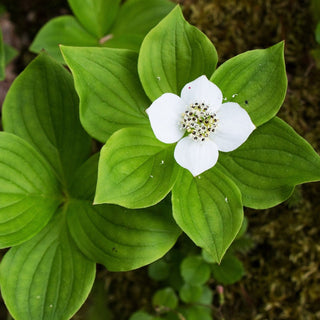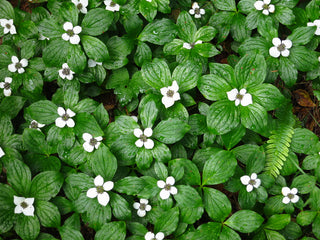Cornus canadensis
BUNCHBERRY
- Unit price
- / per
Description
Cornus canadensis is a species of flowering plant in the dogwood family. Common names include Canadian dwarf cornel, and Canadian bunchberry. Unlike its relatives, which are for the most part substantial trees and shrubs, C. canadensis is a slow-growing herbaceous perennial growing 10–20 cm tall, generally forming a carpet-like mat. It is used as ornamental groundcover in gardens. It prefers moist acidic soil.
In late spring to midsummer, white flowers are produced. Its native distribution includes Japan, North Korea, northeastern China (Jilin Province), the Russian Far East, the northern United States, Colorado, New Mexico, Canada and Greenland. Cornus canadensis typically inhabits montane and boreal coniferous forests, where it is found growing along the margins of moist woods, on old tree stumps, in mossy areas, and among other open and moist habitats.
Type: Hardy perennial
Height: 20 cm, 10"
Hardiness zones: 2-7
Note: Ornamental use only. These seeds and/or plants are poisonous.
Germination: Start these seeds indoors right away for best germination rates. Soak the seeds for 12-24 hours before planting. Sow the seeds just under the surface of a seed-start mix, and water in. First keep them at room temperature for 60 days. This helps break the phytohormones which inhibit germination. Then cover them with plastic to retain moisture, and then place in a fridge for 150 days. Be sure they stay lightly moist. Then bring them to approximately 21°C, 70°F for germination.
Cornus canadensis
BUNCHBERRY
- Unit price
- / per
Multiple secure payment options available.
Adding product to your cart
You may also like
Description
Cornus canadensis is a species of flowering plant in the dogwood family. Common names include Canadian dwarf cornel, and Canadian bunchberry. Unlike its relatives, which are for the most part substantial trees and shrubs, C. canadensis is a slow-growing herbaceous perennial growing 10–20 cm tall, generally forming a carpet-like mat. It is used as ornamental groundcover in gardens. It prefers moist acidic soil.
In late spring to midsummer, white flowers are produced. Its native distribution includes Japan, North Korea, northeastern China (Jilin Province), the Russian Far East, the northern United States, Colorado, New Mexico, Canada and Greenland. Cornus canadensis typically inhabits montane and boreal coniferous forests, where it is found growing along the margins of moist woods, on old tree stumps, in mossy areas, and among other open and moist habitats.
Type: Hardy perennial
Height: 20 cm, 10"
Hardiness zones: 2-7
Note: Ornamental use only. These seeds and/or plants are poisonous.
Germination: Start these seeds indoors right away for best germination rates. Soak the seeds for 12-24 hours before planting. Sow the seeds just under the surface of a seed-start mix, and water in. First keep them at room temperature for 60 days. This helps break the phytohormones which inhibit germination. Then cover them with plastic to retain moisture, and then place in a fridge for 150 days. Be sure they stay lightly moist. Then bring them to approximately 21°C, 70°F for germination.
You may also like
You may also like
Recommended Products
CUSTOMERS ARE ALSO BUYING THESE
Testimonials
Here's What Some Of Our Customers Had To Say (Thank you!)

Ferri Seeds is truly a wonderful company. They take the utmost care when delivering your seeds. Mine arrived promptly and when I had any questions, they were so happy to help me. I am looking forward to getting more from them soon. Thank you David for making this a delightful experience.

I got these pretty quickly and in perfect order. I can't wait to see what they look like once I plant them. I have another colour and they were so pretty I had to try these. I have used this seller a few times now with great success, and will again. Everything I have ordered has been of good quality!

I was impressed with Ferriseed’s selection of seeds. Ordering was a breeze and the seeds arrived in a perfect little padded envelope in 9 days. I am very happy and will order from here again. Many thanks.

Never grew coleus from seed, and it was surprisingly easy. They germinated quickly on my heat mat and grow lights. Can't wait to see them in the garden!

We placed our order on Thursday and received it on Monday. Here in Canada the tracking link is accurate. Ferri seeds tells you when they're shipping and when your order is delivered, the seeds arriving in excellent condition. We will definitely be ordering again this spring. Keep up the good work!

Great product ! All seeds germinated and flourished nicely.

My order, made late afternoon, April 27th, and needed in a bit of a rush, was mailed next morning and arrived in my rural mailbox in BC, May 5th.
Thank you for your cheerful, friendly emails and prompt service. I certainly recommend you others and will be sure to keep an eye on the range of seeds you offer in future.

Gt the delivery on time. One week since i potted the seeds. Some of the seeds are already sprouting so i am very happy so far. No complaints yet

Thank you Ferri Seeds for the timely shipments of seeds I ordered. I have been looking to replace that plant for years.

Excellent service, (fastest!!) Great packaging. Also very appreciated is all of the information on how to 'deal' with perennial seeds! Will order again!! Thank you

Ferri Seeds – one of the best online and most helpful businesses I have ever had dealings with. Quick turnaround, dispatch, and beautifully packaged seeds. What more could you want – beautiful flowers would be nice. Well I am sure they will turn out to be.

The seeds came just as described. I appreciate the good follow-up to my questions also.

Fantastically seedlings. They were well packaged. I planted them right away and they’re growing nicely so far.

Fast service, amazing communication!

I happened across Ferri Seeds website when I Googled a particular plant I’d been looking for. I was impressed by their selection of all types of seeds and their good product descriptions along with detailed germination instructions. I found the site and ordered on a Saturday. On Sunday I got a notice that my order had been shipped! The seeds were in my P.O. box on Friday. Such amazing service. It’s too early to comment on germination rates — I’ve just started the stratification process today.

Received in 1-2 weeks in Canada, Ontario. Everything is as ordered. No issues. Ordered through the official web site.

The Japanese anemone seeds arrived promptly. Thank you Ferri Seeds!!

Very fast I am excited

Customer service excellent. Was able to order streptocarpus seeds. Hard to find.

Thank you for having showy Asters., Birdsnest Delphiniums and Colbalt Delphiniums and Obedient plant seeds in Stock. My butterfly garden is almost now complete. And I am cold stratificationing the seeds.

I had a herbarium project with a short deadline. Ferri Seeds were professional, friendly and sent me Alstroemeria seeds promptly. The seeds arrived in a protective sleeve within a letter envelope. The herbarium is complete! I highly recommend Ferri Seeds! Thank you!

Very good seller!

Very satisfied, quick service

It's been a pleasure dealing with Ferri Seeds!

Amazing selection. Fast service. I look forward to ordering in the future.
We carry a diverse selection of seeds from around the world, many are rare and hard to find!
Regular new seed stock, special cold/dry storage facility, and record keeping ensures our stock is fresh and ready to grow for you.
We welcome your contact. We reply the same day or next business day with a friendly and personalized answer to your inquiry!
When you sign up, you are agreeing to receive promotional emails and other marketing communications from us. In the future, you can always unsubscribe.



